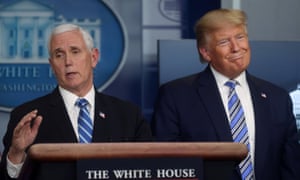A lack of preparation, deep-rooted dysfunction and a reckless president – now the US faces being the center of the pandemic
- Coronavirus – latest updates
- See all our coronavirus coverage

Photograph: Jonathan Ernst/Reuters
Exactly a month after Donald Trump tweeted that the US had the coronavirus outbreak “very much under control”, the World Health Organization delivered a stark and jarring reality check: America faces being the centre of a pandemic that has paralysed much of the world.
Coronavirus has raced across the American continent with the aid of a chronic lack of preparation, deep-rooted dysfunction in the US healthcare system, and a president who has repeatedly dismissed the crisis and is now looking to scale back containment efforts in favour of restarting economic activity.
More than 46,000 people in the US have been diagnosed with Covid-19 and nearly 600 have died. On Monday, for the first time, more than 100 people in the US died in a single day. The sharp acceleration in cases – just two weeks ago the official number was less than 2,000 – has led to the WHO warning that the US is overtaking countries such as Italy as the global hotspot for the virus.
The true scale of infection in the US is almost certainly far worse, with a severe lack of testing having stymied efforts to contain Covid-19 once it emerged near Seattle. Trump initially referred to media coverage of the outbreak as a “hoax” before banning travel from China, where the virus originated, and claiming it had been nearly vanquished on US soil.
But the US response has been hobbled by the administration’s rejection of standard WHO testing kits, instead opting to develop its own, which turned out to be faulty. The Trump administration previously dismantled a federal team working on pandemics and cut back a Centers for Disease Control and Prevention (CDC) group based in China tasked with tracking new threats such as Covid-19.
“The administration has repeatedly and systematically corroded critical parts of the CDC,” said Christopher Sellers, an expert in the environment and health at Stony Brook University. “This was just begging for an epidemic to hit us. It was a perfect storm of lack of preparation.”
Muddled messaging from the White House, where Trump has often contradicted the sombre warnings of his top infectious disease expert, Dr Anthony Fauci, has done little to Americans stop congregating on beaches or in shopping malls.
State governors have taken up the mantle, shutting down public gatherings and non-essential businesses. But a paucity of medical supplies has led doctors and nurses to beg for items online. Dressmakers have been asked to make masks for hospital workers. As one hospital’s equipment supply diminished, one anesthesiologist wore a plastic bag over his head during a procedure.
These shortages have only worsened pre-existing problems. Nearly one in 10 Americans have no health insurance, while a widespread lack of sick pay across the country has forced many ill people into work despite the risk of spreading the virus.
New York City, now at a standstill, faces a tsunami of sick and dying people. More than 2,600 people have been hospitalized in New York state with more than 150 deaths so far.
The “attack rate” of the virus – the percentage of the population infected – is five times higher than in other parts of the country, leading Dr Deborah Birx, the White House coronavirus response coordinator, to warn: “To all of my friends and colleagues in New York, this is the group that needs to absolutely social distance and self-isolate at this time.”
Authorities in New York are scouring the world for the ventilators, masks and gowns needed for an unfolding public health emergency that is expected to peak in the next three weeks.
The Javits Center, a hulking glass conference space in Manhattan, has been transformed into a field hospital, with 2,000 beds installed.
“The apex of this pandemic is higher and sooner than we thought,” said Andrew Cuomo, the New York governor who has garnered praise for his handling of the crisis. “I will turn this state upside down to get the hospital beds we need.”
Cuomo also condemned Fema and the Trump administration again, saying: “You want a pat on the back for sending 400 ventilators? What are we going to do with 400 ventilators when we need 30,000 ventilators? You’re missing the magnitude of the problem, and the problem is defined by the magnitude.”
The number of cases was higher in New York, he said, “because it started here first because we have global travelers coming here first. Because we have more density than other places. You will see this in suburban communities across the country. We are just a test case. We are just a test case. And that’s how the nation should look at it. Where we are today, you will be in three weeks or five weeks or six weeks.”
But even as leaders such as Cuomo scramble to cope with an steep increase of sick patients while urging people to stay at home and avoid social contact, Trump has signaled that he is prepared to wind down restrictions at the end of a 15-day window in an attempt to bolster the economy and a sagging stock market.
“Our country wasn’t built to be shut down,” Trump said on Monday. “This is not a country that was built for this. America will again, and soon, be open for business. I’m not looking at months, I can tell you right now.”
That stance, a reversal on previous assertions that the US was “at war”, put the president once again on a collision course with governors and public health experts.
For tens of millions of anxious Americans, the coming weeks will probably shape the contours of the crisis.


